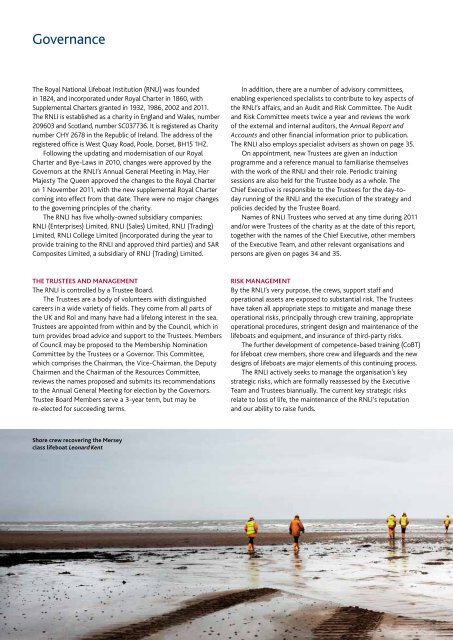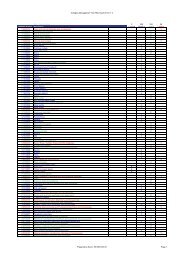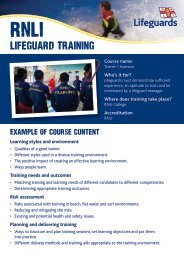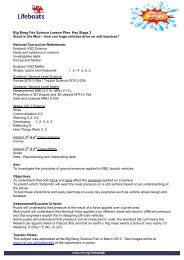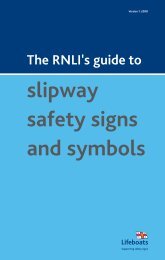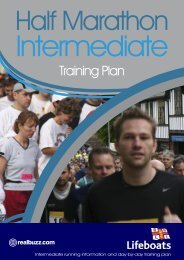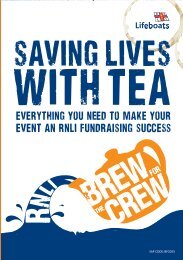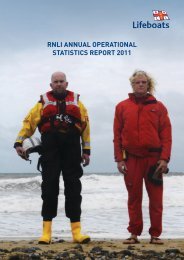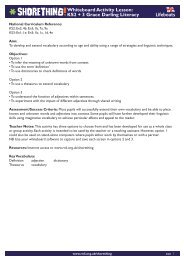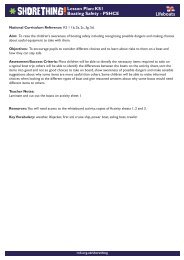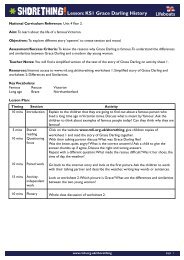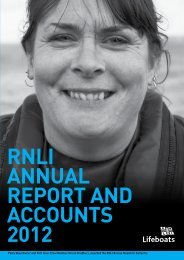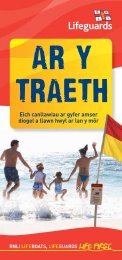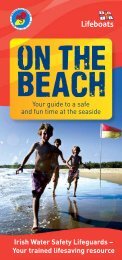RNLI ANNUAL REPORT AND ACCOUNTS 2011
RNLI ANNUAL REPORT AND ACCOUNTS 2011
RNLI ANNUAL REPORT AND ACCOUNTS 2011
- No tags were found...
Create successful ePaper yourself
Turn your PDF publications into a flip-book with our unique Google optimized e-Paper software.
GovernanceThe Royal National Lifeboat Institution (<strong>RNLI</strong>) was foundedin 1824, and incorporated under Royal Charter in 1860, withSupplemental Charters granted in 1932, 1986, 2002 and <strong>2011</strong>.The <strong>RNLI</strong> is established as a charity in England and Wales, number209603 and Scotland, number SC037736. It is registered as Charitynumber CHY 2678 in the Republic of Ireland. The address of theregistered office is West Quay Road, Poole, Dorset, BH15 1HZ.Following the updating and modernisation of our RoyalCharter and Bye-Laws in 2010, changes were approved by theGovernors at the <strong>RNLI</strong>’s Annual General Meeting in May. HerMajesty The Queen approved the changes to the Royal Charteron 1 November <strong>2011</strong>, with the new supplemental Royal Chartercoming into effect from that date. There were no major changesto the governing principles of the charity.The <strong>RNLI</strong> has five wholly-owned subsidiary companies:<strong>RNLI</strong> (Enterprises) Limited, <strong>RNLI</strong> (Sales) Limited, <strong>RNLI</strong> (Trading)Limited, <strong>RNLI</strong> College Limited (incorporated during the year toprovide training to the <strong>RNLI</strong> and approved third parties) and SARComposites Limited, a subsidiary of <strong>RNLI</strong> (Trading) Limited.In addition, there are a number of advisory committees,enabling experienced specialists to contribute to key aspects ofthe <strong>RNLI</strong>’s affairs, and an Audit and Risk Committee. The Auditand Risk Committee meets twice a year and reviews the workof the external and internal auditors, the Annual Report andAccounts and other financial information prior to publication.The <strong>RNLI</strong> also employs specialist advisers as shown on page 35.On appointment, new Trustees are given an inductionprogramme and a reference manual to familiarise themselveswith the work of the <strong>RNLI</strong> and their role. Periodic trainingsessions are also held for the Trustee body as a whole. TheChief Executive is responsible to the Trustees for the day-todayrunning of the <strong>RNLI</strong> and the execution of the strategy andpolicies decided by the Trustee Board.Names of <strong>RNLI</strong> Trustees who served at any time during <strong>2011</strong>and/or were Trustees of the charity as at the date of this report,together with the names of the Chief Executive, other membersof the Executive Team, and other relevant organisations andpersons are given on pages 34 and 35.THE TRUSTEES <strong>AND</strong> MANAGEMENTThe <strong>RNLI</strong> is controlled by a Trustee Board.The Trustees are a body of volunteers with distinguishedcareers in a wide variety of fields. They come from all parts ofthe UK and RoI and many have had a lifelong interest in the sea.Trustees are appointed from within and by the Council, which inturn provides broad advice and support to the Trustees. Membersof Council may be proposed to the Membership NominationCommittee by the Trustees or a Governor. This Committee,which comprises the Chairman, the Vice-Chairman, the DeputyChairmen and the Chairman of the Resources Committee,reviews the names proposed and submits its recommendationsto the Annual General Meeting for election by the Governors.Trustee Board Members serve a 3-year term, but may bere-elected for succeeding terms.RISK MANAGEMENTBy the <strong>RNLI</strong>’s very purpose, the crews, support staff andoperational assets are exposed to substantial risk. The Trusteeshave taken all appropriate steps to mitigate and manage theseoperational risks, principally through crew training, appropriateoperational procedures, stringent design and maintenance of thelifeboats and equipment, and insurance of third-party risks.The further development of competence-based training (CoBT)for lifeboat crew members, shore crew and lifeguards and the newdesigns of lifeboats are major elements of this continuing process.The <strong>RNLI</strong> actively seeks to manage the organisation’s keystrategic risks, which are formally reassessed by the ExecutiveTeam and Trustees biannually. The current key strategic risksrelate to loss of life, the maintenance of the <strong>RNLI</strong>’s reputationand our ability to raise funds.Shore crew recovering the Merseyclass lifeboat Leonard Kent14


